Research point 1…
This research is looking at the design of yarn and sourcing yarn.
This website by woolmark who are the global authority on wool and who highlight the use of Australian wool and is a subsidiary of Australian Wool Innovation. It is set up to inform the industry about the production techniques used… ‘worsted’ which involves more stages in production and results in smooth wool for use in suits,for example, and the ‘woolen’ system which leaves the wool with a more hairy finish ideal for knitwear and tweed. I note the website states that most of Australian wool is used in apparel however after researching further I discovered that wool is great for interiors as it is robust, drapes beautifully and is anti static and fire retardant naturally! . They list the benefits of wool as… Natural, biodegradable, renewable, soft, elastic, breathable, warm and cool [responding to your bodies temp], machine washable, stain and odour resistant and fire retardant amongst other things!
Wool has many different finishes depending on how its made into a textile, knitted or woven, and it drapes beautifully. Woolen fabric will cut cleanly and holds its shape, it won’t show pin marks and can hold a permanent pleat.
I noticed on the site that wool can be used for sports apparel which surprised me as I thought it would be too heavy but of course it can be spun and knitted finely and its natural moisture wicking properties and temperature control make it perfect!
Woolmarks website also states that ‘The Woolmark Company’s Wool Appreciation Courses are free workshops offering insight into the production pipeline of Merino wool apparel – from fibre to garment – and details the unique benefits, performance and fabric attributes of wool and wool products. It answers the questions of what is wool, outlines the benefits and properties of wool and details the uses of wool.’
Cotton inc website states that it is a ‘partner and resource to help you make outstanding cotton products’ They have a university where you can learn about all different aspects of cotton manufacture and its uses, it is an online university and free to access. Cotton is a popular material and promoted for being a natural textile. It can be used for personal care [cotton buds, cotton wool, etc,] and a textile for apparel and interiors. It is non-woven for personal care products and woven or knitted for apparel and interiors.
Invista are a manufacturing company of man made fibres. They create fibres for use in apparel, furniture, interiors, carpets, car furnishings and more. They claim to be sustainable and want to be ‘good stewards’ of the environment and their workers. Invista has a large range of brands including Lycra, cool max and stainmaster, making them a versatile manufacturer able to hit many markets.
Examples of unusual yarns …here I really like the yarns with elements added… and these
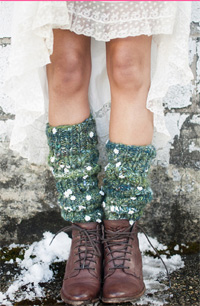 the yarn used for these leg warmers has random daisy flowers woven in …
the yarn used for these leg warmers has random daisy flowers woven in …
more unusual yarns …
this yarn is constructed as a ladder …
Project 1 Exploring Lines.
These are the pieces of work I drew from to create my yarn explorations. I decided to continue working in just black and white with some metallic elements as I like the simplicity and sharp contrasts. First I decided to create a word list of my thoughts about the work to help me direct my experiments : Industrial, linear, monochrome, sharp, angular, strong,
During my research I found yarns with elements added which I really liked so I decided to use some metallic elements.
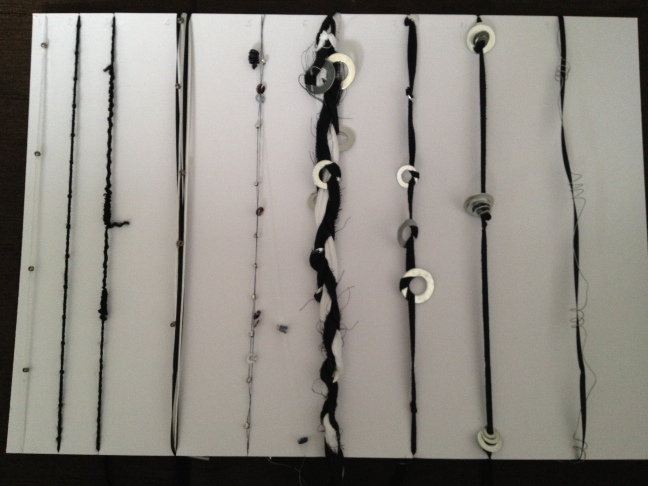
The first yarn is white acrylic wool knotted at intervals and a metallic bead added. The acrylic yarn is very soft and lightweight adding the beads has made it less fly away. The second yarn is, again, acrylic but black and I added knots at regular intervals it has given it a nubby feel but not created any additional weight to it. I decided to knit up these yarns and see how they came up.
This sample is knitted from the acrylic yarn as is… as I have knitted two together the sample is quite structured but very soft and smooth to touch.
This sample is the knotted yarn and the beaded yarn knitted together the extra elements add weight and give the sample a nubbly feel and feels sturdy I think it would hold a stiffer finish than the plain yarn. The knots can’t be seen but can be felt and definitely make the sample feel different. The beads can be seen and felt and give weight to the sample. Although I spaced them evenly where they fall in the knitting appears quite random also more show on what would be, traditionally, the back of the sample. I prefer the back. Thinking back to my work which influences this yarn development I do feel I have captured the slub that was in the silk.
The third yarn is the acrylic yarn and I have snipped through some of the ply and bunched it up to create thicker and thinner parts again its going back to the slub in silk. The yarn feels very light and soft but thick where the ‘slub’ is.
Number 4 on the sample card is 4ply, two ribbon and two chord I added metallic beads to one of the chord strands, the chord in contrast to the ribbon is stiff and holds its structure, I was influenced by the long white stitches on my stitch samples against the black fabric. I added the bead element to continue my experiment of adding elements to my yarn.
Number 5 is 4ply as above but I used cotton sewing thread, again two white and two black and I added elements to create a slub. The elements help to weigh down the otherwise very lightweight thread. Its a very delicate yarn despite the added elements.
Number 6 is 3ply two black and two white. Its made from cotton fabric ripped into long strips and plaited together I added washers to give it an industrial feel, its heavy and quite structured although leaving the edges to fray helps it look softer and less rigid.
Number 7 & 8 I used cotton tape and added washers keeping to the industrial feel I felt from my patchwork. The cotton tape is a good weight to support the washers I knitted a sample of number 7 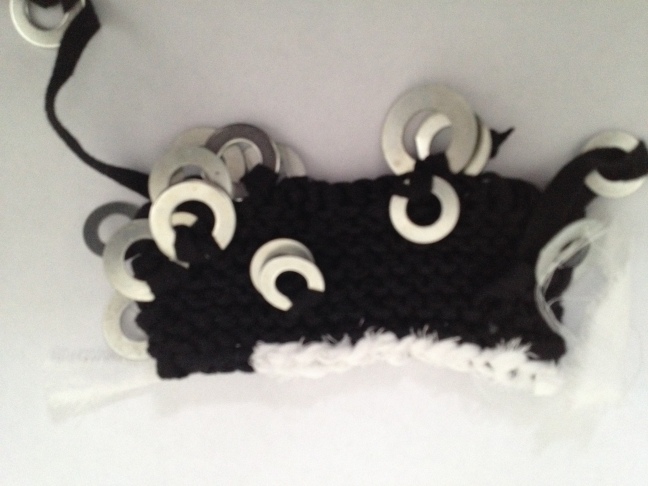
Its a very sturdy piece and I love how the washers have kind of bunched together! I also love the sound they make! I could see this made up as a boxy cardigan/jacket it would hold its shape and the weight of it is lovely.
For my final sample I used ribbon and, in contrast, wire twisting the wire at intervals which resembles the slub but was actually influenced by the black and white patchwork where I gave it a silver uniform grid which gave the fabric structure. Here the wire gives the ribbon more structure however the ribbon still has room to twist and curve.
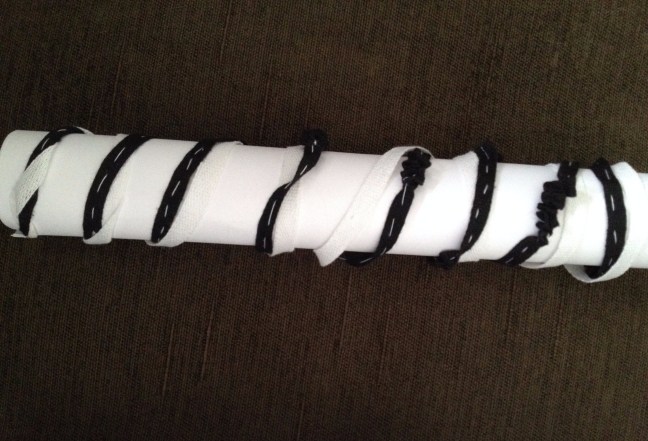
My first longer sample is 2ply black cotton tape and white cotton tape. I used white thread to stitch the black tape and gathered at intervals creating a bunch at intervals. I developed the idea after creating a slub with the acrylic yarn by cutting and bunching. This is sturdier and more uniform but it still has a fluid feel to it but not as flyaway as the acrylic yarn.
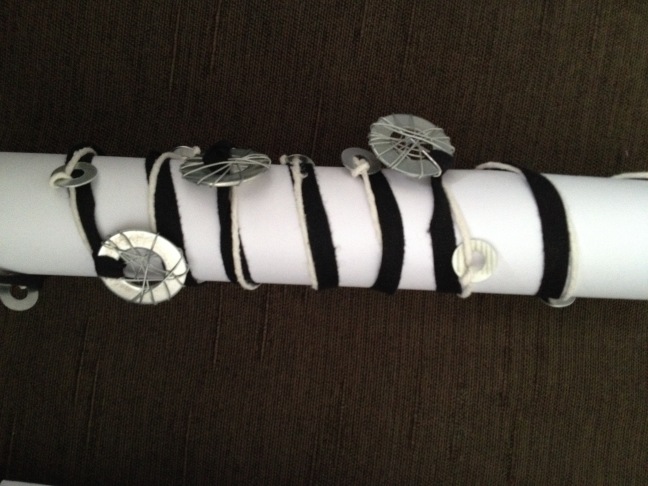
This time I used cotton tape, black, and white string I threaded washers onto both. I added some wire to some of the washers to build on the silver grid from my patchwork. The washers weigh the threads down but I have left enough space between the elements so the yarn can still move fluidly.
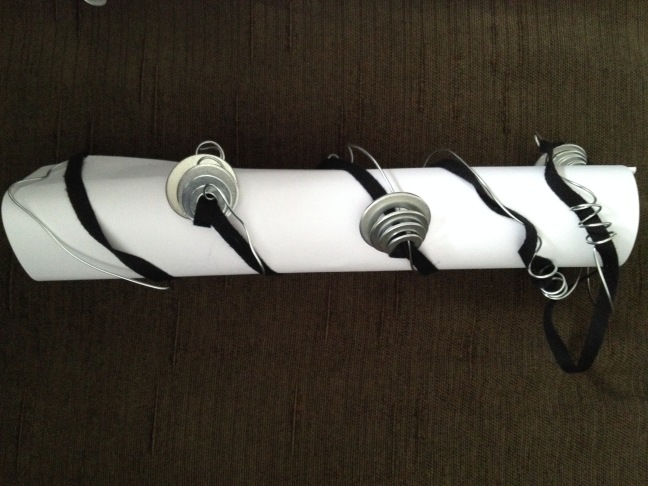
This sample is similar to before but instead of string I have used wire and black tape, I have twisted the wire at intervals and threaded washers onto the tape then twisted them together. I really like this visually but as a yarn the drawback is the metal wire holds whatever shape it is put into so there is little movement or flow.
Exercise 4.2 Experimental yarns and concepts.
- Colour placement and composition.

Using the above colour palette I created this series of yarns.
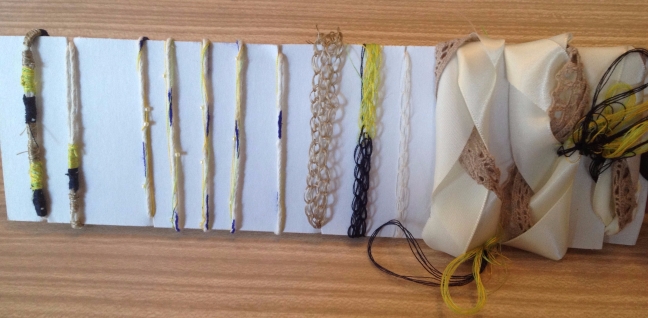
The first yarn has sewing thread wrapped around string. I used two strands of string then wrapped the thread around. I tried to use the same proportion of colour as in the original piece. The second yarn is one strand of string I added some dashes of navy using pen then wrapped the green and yellow thread loosely around it I added some yellow beads which added some flecks of additional colour. The original sample has flecks where the print hasn’t taken but there is colour all around. I next use the sewing thread and using it multi-plyed to give it more structure I used it to french knit, I didn’t use the colours proportionally but did and even pattern, I like the way the space between the stitches gives light and space. Finally I used ribbon and lace and plaited them then using multi strands of colour I added bows at intervals. I like the chunky nature of this exploration and the sheen from the ribbon.
2 Materials exploration.
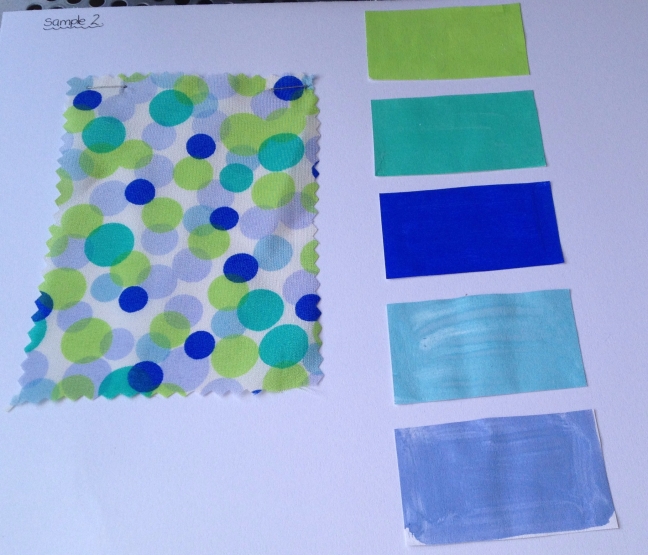
I used this sample but as I was thinking about the materials I was led to use I didn’t manage to match the colours. This piece made me thinks of buttons and the blobs of acrylic paint I have left after projects! I also thought about the translucency of the silk and tried to recreate that with some glue gun strands!
I knitted up the buttons threaded onto the wool, I really like the effect. Although the acrylic paint on the glue strands is very stiff I do think it looks quite soft and translucent.
3 Texture and tonal qualities.
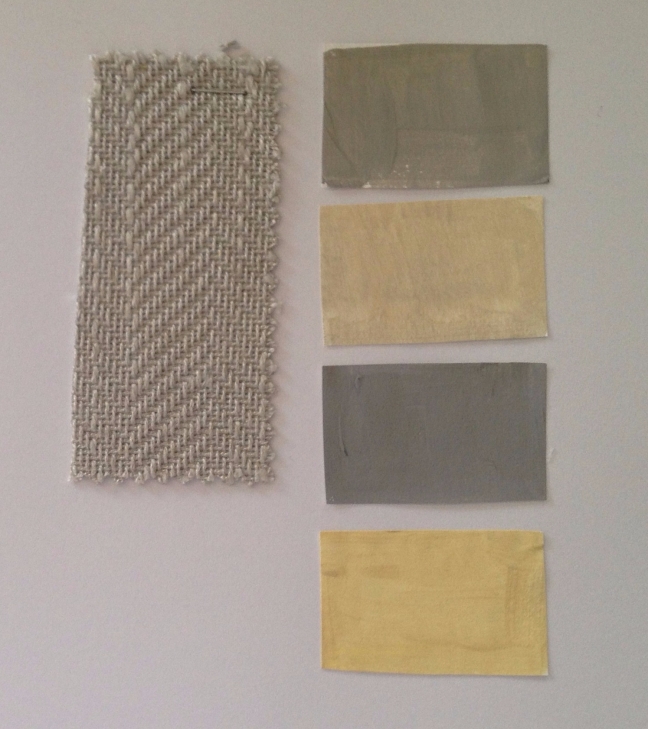
Using this sample I created a word list… crunchy, natural, uniform, symmetry, shimmer, glisten.
the first image I used a cotton lace and added some gold pins for the symmetry and glint of gold. The next image is three strands of string sewn with embroidery thread creating a ladder effect. Next I tried knotting some string it gave a lovely crunchy texture. I then used a single strand of string and did some finger knitting it also created a crunchy texture but because of the space between it is lighter and more flexible. I then used three strands of string and knotted at intervals. Finally I used some sequins and beads on thread and threaded in a uniform manner creating a fluid structure.
Project 2 Creating Linear Forms.
Review point – Demonstration of creativity.
I feel Ihavetaken quite a long time to begin to be truly creative and I am still just scratching the surface. I have tended to Lat the brief contain me rather than propel me! However as I work through the course I am finding that my creative muscles are becoming more flexible and I Am beginning to push boundaries and explore more freely.
In this section I have pushed my yarn exploration combining different methods of construction and exploring different materials and then making up some yarns to see what effects I have achieved.
Im not creative when presenting my work I favour keeping it simple. I have been looking at how other students present their work and also textile artists and although simple is best it also needs to be well presented this is an area I will keep working on.
I feel as I am working through the course I am beginning to find my own voice and style but it’s just a whisper at the moment. I think as I research more I will get a sense of where I want to go as an artist. It’s also about having the confidence and conviction to follow my path.
i am passionate about the environment and the use of found items and up cycling really interests me but this isn’t showing in my work. I am pleased with my progress so far but look forward to growing more confident as an artist and taking risks!
Exercise 4.3 Re-interpret, re-invent
I decided to explore macramé This site was helpful and And this YouTube video showed different knots This was my first time trying macrame I liked the crunchy texture of the yarn created and when I made a braid I liked the uniformity and the strength of the piece. 
I remember French knitting as a child so after reading the instructions that came with the kit I was quickly able to make a yarn. I used acrylic yarn it has made a lovely even lightweight yarn which has a good shape and structure.
Next I tried finger knitting I used acrylic yarn. The result is less uniform and flatter than French knitting but I like the ‘airy’ feel also I found I could use thicker yarns such as ribbon to finger knit where as the French knitting ‘doll’ wouldn’t take thicker yarn.
I then crocheted a chain in acrylic, I have done basic crochet before it has the same flatter properties of the finger knit but is much more uniform with less spaces between the stitches.
I then crocheted three chains together this created a flatter more dense yarn. I used these techniques in building my samples and combined some of the techniques to create interesting samples.
I really enjoyed making these samples based on my old masters painting work.
I used the techniques I had tried sampling and combined them. I love all the different textures and the way the colours blend. I found this really interesting, using different yarns and different techniques to reinterpret this painting.
Exercise 4.4 Deconstructing colour as yarn.
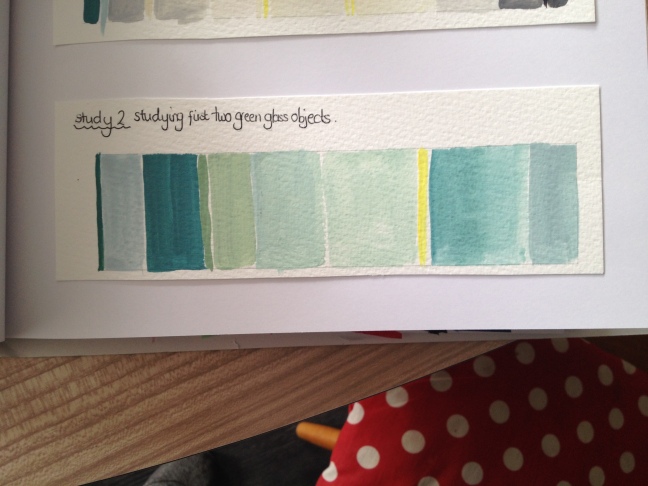
I used this colour palette to inspire this project. I gathered materials which I could fade, deconstruct and use to make my yarns.
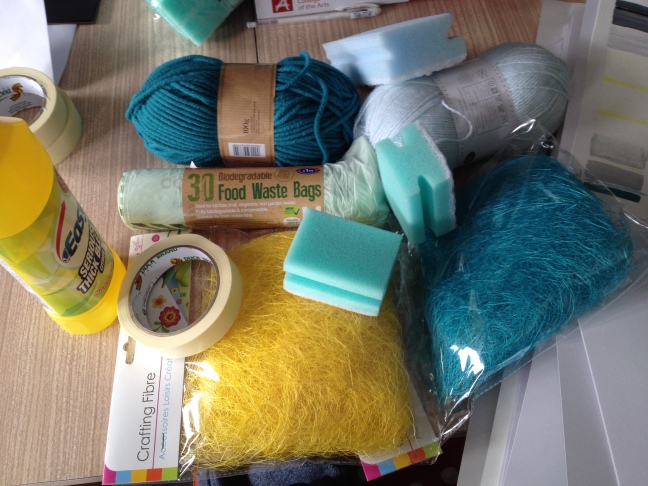
I then looked at how to achieve useable materials to create yarns.
I sliced sponges to make them less opaque and just smaller and more usable. I took the acrylic yarn and separated the strands it was quite thick and separating not only made it thinner it also had a wavy texture which felt light and watery. I tried to bleach the yarn to fade it but despite using full strength bleach it had no effect whatsoever! I also tried bleaching a sponge but it just turned the sponge brown definitely not what I was hoping for! I am guessing the unexpected results came about because these are synthetic products. I took some waste bags and sliced them into long yarns and used bleach to fade the green logo a little. I also found some craft fibre which I split into single strands to use.
I enjoyed combining unusual materials to create these yarn explorations. I struggle to see these developing into usable yarns but I can see that I might be able to pull out elements and develop them further… unfortunately there’s no time now! I also began to get comfortable about pulling out colour elements and creating interesting yarns and again I look forward to being able to do this and create yarn ideas that would be usable and unique in the way the colours were worked in.
Exercise 4.5 Collage inspired yarn.
I decided to limit myself to my black and white collages for inspiration.
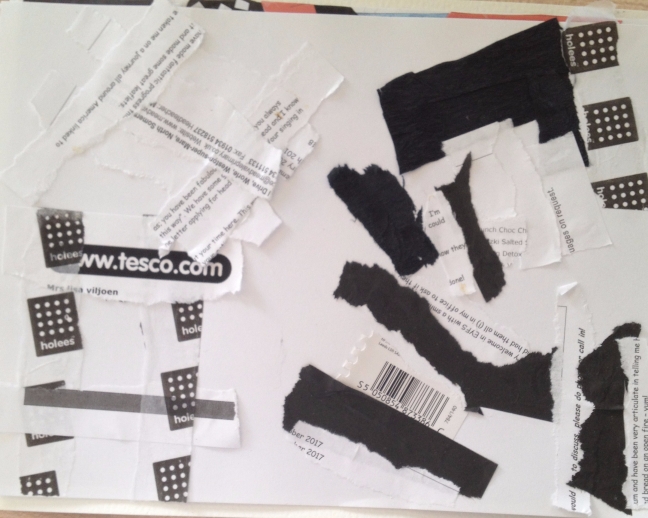
I really enjoyed this and found I could be very expressive. Limiting my colour palette helped me to focus on the shapes in the collage.
I tried to create a flat yarn with crochet but it curled up too much. I used some glue gun strands again overlaid on ribbon. My first sample is white cotton tape and I have sewn on black sequins with a running thread in black all the way through. On my collage there are white holes so I reversed the colours and had black ‘holes’ I added the running stitch in a line following the flow of the writing on the collage. My next sample is a ripped piece of black poly cotton with glue gun over the top and white spots the glue gives a grid inspired by the bar codes and the white spots are the holes. The next piece is white cotton with checked cotton squares sewn on the squares create a similar effect to the rectangles of holes in the print. Next I chose to use the squares as the base and ad lines of white and black with the sequins sewn on I love the grid effect it has created and finally white cotton with black ribbon and buttons with sequins. I deliberately used white buttons and black thread as the four holes in the button create a nice symmetrical, uniform shape. I added the sequins in a more random pattern so this piece has uniformity and randomness working alongside each other. I am really pleased with these I found this exercise really interesting and inspiring.
Written reflection.
I have found the exercises challenging and interesting. There are times when I find I am just too practical thinking about how would that actually work as a yarn? instead of exploring and pushing boundaries. I do feel that as I work through the projects I am becoming less ‘law abiding’ and more experimental.
I really want to start addressing my presentation as I feel it is a bit underwhelming! I do think each time I am getting better but I don’t allow enough time to give my presentation attention it tends to be a rush at the end! I am definitely going to start looking at textile artists and other OCA students for inspiration.
Recycling and upcycling is so important to me but that it not reflected in my work! I think it takes more time to collect resources when you can’t just pop to the shops and get them but I would like my work to reflect my priorities a bit more so I am going to start incorporation more found items in my work and perhaps for display purposes. I have often researched artists who use found objects and there is a lot of inspiration out there! I might have to learn some new skills to be able to use found objects in my work as simply sewing or sticking might not work!
I really love the black and white work I have done I had my yarns displayed for a while and visitors couldn’t help but touch and spend time looking at them and I felt the same they were so clean and crisp but interesting and tactile. It set me thinking Imagine art that touched more of the senses not just sight, but touch and sound the buttons and washers jingling together sounds lovely! Imagine a garment where a visually impaired person can feel the texture and also hear sound as they move! Or a cushion cover/blanket that feels and sounds divine!? I’m not sure I could find a way to put smell in there though!!
In conclusion I feel like I am waking up to being more creative and thinking outside of the box. I also feel my own voice is starting to show in my work but still a way to go! I had more time for this unit and I think it shows I was able to push through more and I am happier with the work I have produced. My focus now will be intigrating my core values into my work and presentation!















































